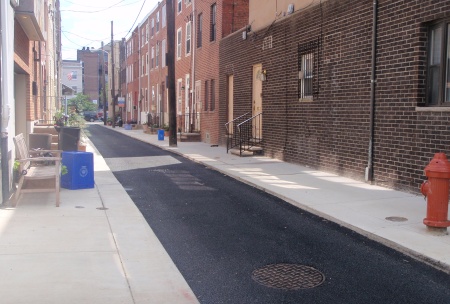
Porous paving on Percy Street in South Philadelphia. It looks just like regular asphalt. We know.
An article in yesterday’s National Geographic daily news lauds the Philadelphia Water Department’s Green City, Clean Waters plan and makes some interesting points about Philly’s tradition of innovation in water management. Did you know porous paving was invented at the Franklin Institute? Writer Paul McRandle reminds us:
Philadelphia’s history of water-related invention extends back at least to Ben Franklin’s swim fins and glass armonica, but the city is less well known for an invention that will soon cover a sizable portion of it—permeable paving. Developed at the city’s Franklin Institute in 1977, permeable (also known as “porous” or “pervious”) paving provides a surface tough enough to bear traffic while allowing water to seep through its matrix and into the soil, eliminating surface pooling.
An integral part of Philadelphia’s green streets plan, permeable paving will replace 15 square miles of impervious paving within the city’s CSO area in a little over 20 years. As [PWD Deputy Commissioner of Environmental Services Chris] Crockett notes, that’s the equivalent of more than a thousand city blocks.
The city is also testing a variety of designs for other street elements—including 20 different types of tree trenches. Above ground, these look no different from street tree plantings elsewhere, but below the paving the structure is engineered to hold water to nourish the trees and allow some to enter the ground beneath.
Read the whole article here.